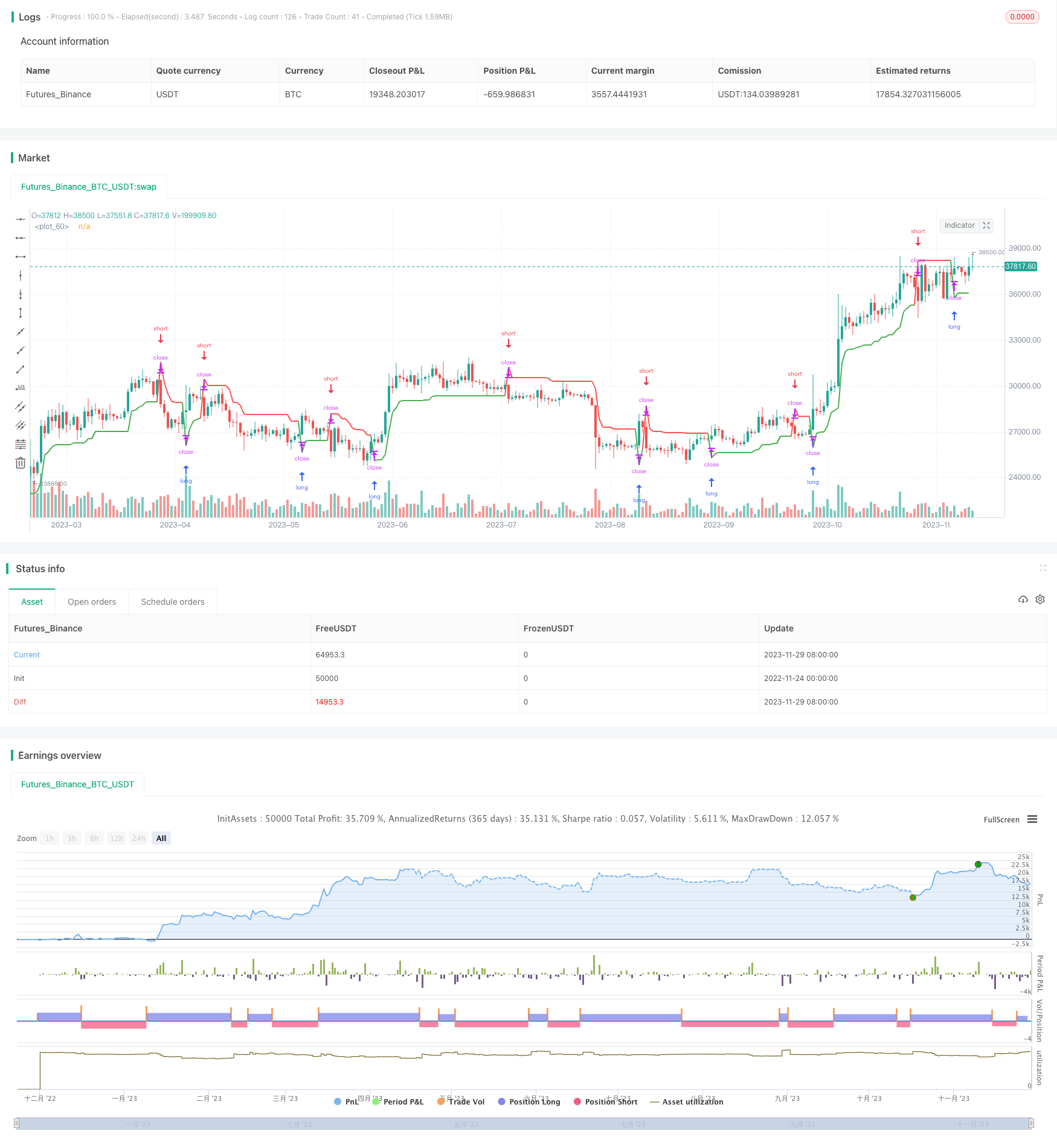Name
跟踪止损反转策略Trailing-Stop-Loss-Reversal-Strategy
Author
ChaoZhang
Strategy Description
这是一个非常简单的策略。它只由一个跟踪止损组成。当止损被触发时,仓位被反转,并对新的仓位设置一个跟踪止损。
该策略基于三种止损类型之一构建:百分比止损、ATR止损、绝对止损。当止损被触发时,仓位被反转,并对新的仓位设置一个跟踪止损。
具体来说,策略首先根据选择的止损类型计算出止损值。然后它会判断是否有建仓信号,即高点大于之前的止损价时做多,低点小于之前的止损价时做空。进场后,它会实时更新止损价,使其跟踪价格变化。多头止损价为低点减去止损值,空头止损价为高点加上止损值。
该策略最大的优势在于非常简单,只需要跟踪一个止损,不需要考虑入场点选和出场点选。止损值的灵活设置也使其适用范围更广。
相比固定止损,它采用的跟踪止损可以锁定更大的获利,同时也降低了止损被冲击的概率。每次止损触发后反转仓位,可以捕捉价格反转机会。
该策略可能存在的主要风险是止损价设置不当导致的风险。止损值设置过大,可能导致亏损扩大;止损值设置过小,可能导致止损频繁被触发。这需要根据市场情况针对性优化。
另一个风险是止损触发后反转仓位的方向判断不准确,从而错过价格反转机会或增加亏损。这需要结合趋势和支撑阻力判断确定最佳反转时机。
该策略可以从以下几个方面进行优化:
- 增加对趋势的判断,避免逆势建仓
- 优化止损值的计算方式,使其更加动态地跟踪市场
- 增加对突破的判断,确保更高概率的反转信号
- 结合波动率等指标确定最佳的反转时机
该策略通过简单的跟踪止损机制实现盈利,是一种适合初学者掌握的量化策略。与传统止损策略相比,它增加了止损触发后反转建仓的机制,从而获取额外收益。通过不断测试和优化,该策略可以成为一个非常实用的量化程序。
||
This is a very simple strategy. It consists of only one trailing stop loss. When the stop loss is triggered, the position is reversed and a trailing stop loss is set for the new position.
The strategy is built based on one of three stop loss types: percentage stop loss, ATR stop loss, absolute stop loss. When the stop loss is triggered, the position is reversed and a trailing stop loss is set for the new position.
Specifically, the strategy first calculates the stop loss value based on the chosen stop loss type. It then checks for entry signals, going long when high is above previous stop loss price and going short when low is below previous stop loss price. After entering, it keeps updating the stop loss price to trail price changes. Long stop loss price is low minus stop loss value, short stop loss price is high plus stop loss value.
The biggest advantage of this strategy is its simplicity, requiring tracking of only one stop loss without needing to consider entry and exit point selections. Flexible setting of stop loss value also makes its application scope wider.
Compared with fixed stop loss, the trailing stop loss it employs can lock in larger profits while also reducing the probability of stop loss being hit. Reversing positions each time stop loss is triggered allows capturing price reversal opportunities.
The main risks of this strategy may come from improper stop loss value setting. Overly large stop loss value may lead to magnified losses, while overly small value may cause frequent stop loss triggering. This requires adaptive optimization based on market conditions.
Another risk is inaccurate directional judgment after stop loss trigger when reversing positions, thus missing price reversal chances or increasing losses. This needs combining trend and support/resistance analysis to determine optimal reversal timing.
The strategy can be optimized in the following aspects:
- Add trend judgment to avoid trading against trends
- Optimize stop loss value calculation to make it more dynamically track the market
- Increase breakout validation for higher-probability reversal signals
- Incorporate volatility measures to find best reversal timing
The strategy realizes profits through a simple trailing stop loss mechanism and is easy for beginners to grasp. Compared to traditional stop loss strategies, it adds post stop loss trigger reversal positions to acquire additional gains. With continuous testing and optimization, it can become a very practical quantitative program.
[/trans]
Strategy Arguments
| Argument | Default | Description |
|---|---|---|
| v_input_1 | 0 | sl_type: % |
| v_input_2 | 4 | % SL |
| v_input_3 | 10 | ATR Length |
| v_input_4 | 2 | ATR Mult |
| v_input_5 | 10 | Absolute SL |
| v_input_6 | true | From Day |
| v_input_7 | true | From Month |
| v_input_8 | 2016 | From Year |
| v_input_9 | true | To Day |
| v_input_10 | true | To Month |
| v_input_11 | 2100 | To Year |
Source (PineScript)
/*backtest
start: 2022-11-24 00:00:00
end: 2023-11-30 00:00:00
period: 1d
basePeriod: 1h
exchanges: [{"eid":"Futures_Binance","currency":"BTC_USDT"}]
*/
//@version=4
strategy(title="Trailing SL Strategy [QuantNomad]", shorttitle = "TrailingSL [QN]", overlay = true, default_qty_type = strategy.percent_of_equity, default_qty_value = 50)
////////////
// Inputs //
sl_type = input("%", options = ["%", "ATR", "Absolute"])
sl_perc = input(4, title = "% SL", type = input.float)
atr_length = input(10, title = "ATR Length")
atr_mult = input(2, title = "ATR Mult", type = input.float)
sl_absol = input(10, title = "Absolute SL", type = input.float)
// BACKTESTING RANGE
// From Date Inputs
fromDay = input(defval = 1, title = "From Day", minval = 1, maxval = 31)
fromMonth = input(defval = 1, title = "From Month", minval = 1, maxval = 12)
fromYear = input(defval = 2016, title = "From Year", minval = 1970)
// To Date Inputs
toDay = input(defval = 1, title = "To Day", minval = 1, maxval = 31)
toMonth = input(defval = 1, title = "To Month", minval = 1, maxval = 12)
toYear = input(defval = 2100, title = "To Year", minval = 1970)
// Calculate start/end date and time condition
startDate = timestamp(fromYear, fromMonth, fromDay, 00, 00)
finishDate = timestamp(toYear, toMonth, toDay, 00, 00)
time_cond = time >= startDate and time <= finishDate
//////////////////
// CALCULATIONS //
// SL values
sl_val = sl_type == "ATR" ? atr_mult * atr(atr_length) :
sl_type == "Absolute" ? sl_absol :
close * sl_perc / 100
// Init Variables
pos = 0
trailing_sl = 0.0
// Signals
long_signal = nz(pos[1]) != 1 and high > nz(trailing_sl[1])
short_signal = nz(pos[1]) != -1 and low < nz(trailing_sl[1])
// Calculate SL
trailing_sl := short_signal ? high + sl_val :
long_signal ? low - sl_val :
nz(pos[1]) == 1 ? max(low - sl_val, nz(trailing_sl[1])) :
nz(pos[1]) == -1 ? min(high + sl_val, nz(trailing_sl[1])) :
nz(trailing_sl[1])
// Position var
pos := long_signal ? 1 : short_signal ? -1 : nz(pos[1])
//////////////
// PLOTINGS //
plot(trailing_sl, linewidth = 2, color = pos == 1 ? color.green : color.red)
//////////////
// STRATEGY //
if (time_cond and pos != 1)
strategy.entry("long", true, stop = trailing_sl)
if (time_cond and pos != -1)
strategy.entry("short", false, stop = trailing_sl)
Detail
https://www.fmz.com/strategy/433902
Last Modified
2023-12-01 13:41:41
